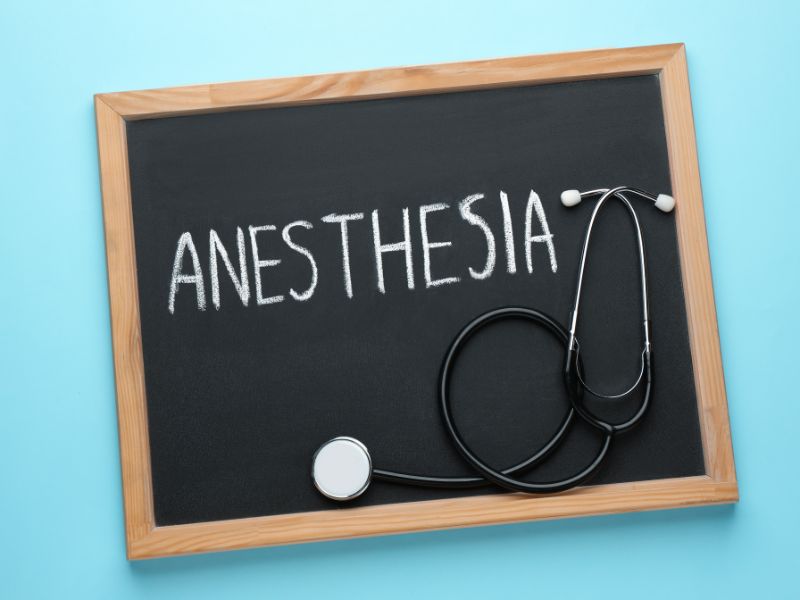Types of Anesthesia for Oral Surgery

The history of anesthesia dates back nearly 180 years. Anesthetics have come a long way since then and are an important tool to keep patients comfortable during dental procedures and oral surgery.
Anesthesia refers to lack or loss of sensation. This state is induced by local anesthetic or general anesthetic. Dental sedation can be combined with local anesthesia to relax nervous patients. Which methods of anesthesia and sedation are used depends on the type of procedure, its complexity, length of the procedure, and the patient’s age and health. With different options available, anesthesia can be confusing for patients. In this post, Des Moines Oral Surgeons PC looks at the types of anesthesia used in oral surgery.
Types of Oral Surgery
Either general or local anesthesia is used in all types of oral surgery, including:
- Surgical removal of wisdom teeth. Wisdom teeth that remain lodged beneath the gum line may need to be removed surgically piece by piece.
- Surgical root canal treatment. Root canal surgery might be necessary if infection or damage to a tooth is extensive or complex.
- Jaw surgery. Corrective jaw surgery – also known as orthognathic surgery – moves jaw bones and teeth in order to improve an uneven bit (malocclusion).
- Bone grafting. Dental bone grafts add volume and density to jawbone in dental implant treatment and jaw surgery.
- Periodontal surgery. Periodontal surgery treats advanced gum disease by repositioning bone and soft tissue.
- Sleep apnea surgery. Surgical techniques to treat sleep apnea include moving the jaw forward to create more space behind the tongue and the soft palate.
General Anesthesia in Oral Surgery
General anesthesia is used for longer, major oral surgery and renders the patient completely unconscious. The medication is given through an intravenous drip or breathed in through a mask. General anesthetic has to be administered by a qualified anesthesiologist, because many of the body’s functions will slow down or need help to work properly.
During the surgical procedure, the anesthesiologist will monitor your vital signs – temperature, heart rate, blood pressure, and breathing. Drugs used to induce general anesthesia include propofol and ketamine. Afterward, you’ll remember nothing of the surgical procedure. Oral surgery procedures that typically require general anesthesia include corrective jaw surgery and major dental bone grafts.
Local Anesthesia in Oral Surgery
Local anesthetic blocks pain in a specific area of the mouth. It’s typically used in more minor oral surgery procedures such as dental implants, extraction of impacted wisdom teeth, and minor dental bone grafts. The injection of an anesthetic drug such as lidocaine, ropivacaine, or bupivacaine temporarily prevents nerves from feeling or transmitting pain. You remain fully conscious throughout the surgical procedure. Side effects are rare and usually mild.
Dental Sedation in Oral Surgery
The terms dental anesthesia and dental sedation are often mistakenly regarded as the same thing. There is, however, a difference. Local or general anesthesia blocks pain; dental sedation blocks anxiety by reducing the level of consciousness. Sedation can be minimal, moderate, or deep.
Minimal Dental Sedation
Minimal dental sedation – anxiolysis – relaxes you but you stay awake. It can be induced orally, through inhalation, or by combining both methods. Drugs commonly used in oral sedation include Valium (diazepam) and the benzodiazepine Halcion (triazolam). They work on the central nervous system to lessen anxiety by toning down activity in certain receptors in the brain. You take a pill about an hour before your procedure. With inhalation minimal sedation, you breathe in nitrous oxide (laughing gas) and oxygen through a mask. The nitrous oxide (N2O) relaxes you by inducing a calm state of mind. It works fast and the effects tend to wear off quickly too.
Moderate Dental Sedation
Moderate dental sedation – intravenous (IV) sedation – involves administering an anti-anxiety drug via a drip placed in a vein in the arm or back of the hand. It works fast, and the level of dosage is based on the treatment required and length of the procedure. Moderate sedation can induce varying levels of consciousness, so you become less aware of your surroundings. However, you remain awake and can understand and respond to your oral surgeon. You’ll remember little if anything about the procedure afterward. The drug most commonly used in moderate sedation is the benzodiazepine midazolam, branded as Versed.
Deep Dental Sedation
Deep dental sedation comes to general anesthesia. It depresses consciousness to such a level that you may need help breathing. You may be given oxygen through a mask or through tubes in the nose. Oxygen levels, heart rate, blood pressure, and breathing are monitored throughout the procedure. The effects of deep sedation gradually diminish over the following 24 hours, but you’ll remember nothing about the procedure. Drugs in deep dental sedation can be given with a shot, a pill, inhalation, or intravenously. Propofol (Diprivan), a hypnotic sedative agent, is often used for deep sedation.
Side Effects of Dental Anesthesia
Side effects of dental anesthesia depend on the type of anesthetic and can vary from person to person. Most people don’t experience an adverse reaction to local anesthetic, which, with or without sedation, is the safest kind of anesthesia. Risks are greater with general anesthesia, especially in older people and those with health complications.
Potential side effects of anesthesia and sedation include:
- Vomiting or nausea.
- Headache.
- Sweating or shivering.
- Dry mouth.
- Sore throat.
- Fatigue.
Medical conditions that increase the risk of unpleasant side effects from anesthetics include:
- Sleep apnea.
- Obesity.
- High blood pressure.
- Heart problems.
Who Can Administer General Anesthetic for Oral Surgery?
General dentists can perform minor surgical procedures such as dental implants using local anesthetic. But that doesn’t make them oral surgeons, and they can’t induce general anesthesia. Oral surgeons – oral and maxillofacial surgeons (OMSs), to give them their full title – are specialists recognized by the American Dental Association (ADA) as the experts in mouth, jaw, and face surgery.
They’re the only dentists with specialized training in anesthesiology. This training takes place over a minimum four years in a hospital-based residency program that includes anesthesiology. This makes OMSs the only dental professionals who can legally administer general anesthetic.
In addition to in-office local anesthesia, oral and maxillofacial surgeons at Des Moines Oral Surgeons PC perform surgeries requiring general anesthesia or IV sedation in an out-office surgical suite.











